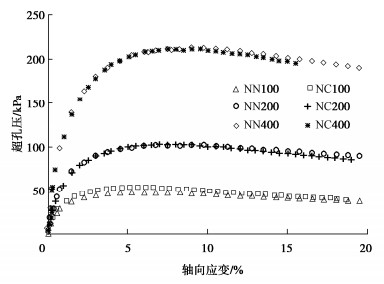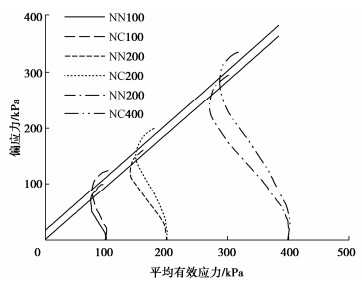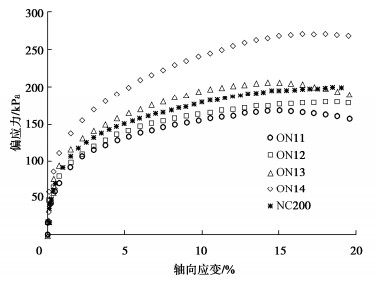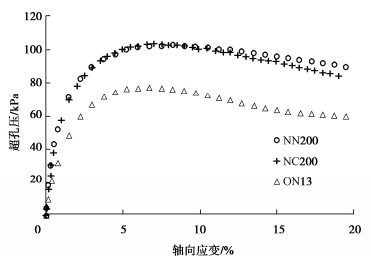Experimental study on effects of heating-cooling cycles on shear characteristics of clay
-
摘要: 采用温控三轴仪,对升降温作用后的正常固结饱和黏土进行了固结不排水剪切试验,研究了升降温作用对土体强度、有效应力路径、超孔压等的影响。结果表明,在100,200,400 kPa固结围压下,土样在升降温作用后呈现出类似超固结土的特性,固结不排水剪切强度分别提高了25.8%,22.1%,14.8%。强度的变化主要表现为黏聚力的提高,临界摩擦角基本保持不变。对比室温下不同超固结比(OCR)土样的固结不排水剪切试验结果,发现升降温作用后土样的峰值强度与OCR=1.5的土样相近,但升降温作用过程中产生的塑性体积应变增量远小于力学加-卸载所产生的,表明升降温作用对土体的硬化作用与超固结土的体积硬化机理有所区别。Abstract: The consolidated undrained shear tests on the normally consolidated saturated clay after heating-cooling are carried out by using the temperature-controlled triaxial apparatus. The effects of the heating-cooling on the soil strength, effective stress path and excess pore pressure are studied. The results show that under the confining pressures of 100, 200, 400 kPa, the soil samples exhibit similar characteristics to those of the overconsolidated soil after heating-cooling, and the consolidated undrained shear strength increases by 25.8%, 22.1% and 14.8%, respectively. The change of strength mainly shows the improvement of cohesion, and the critical friction angle basically remains unchanged. By comparing the consolidated undrained shear test results of the soil samples with different OCRs at room temperature, it is found that the peak strength of the soil samples after heating-cooling is similar to that when OCR=1.5, but the increment of plastic volumetric strain generated during heating-cooling is much smaller than that generated by mechanical loading and unloading, which indicates that the hardening effects of heating-cooling on soil are different from the volumetric hardening mechanism of the overconsolidated soil.
-
Keywords:
- clay /
- heating-cooling /
- triaxial test /
- shear characteristic
-
-
表 1 试验方案
Table 1 Test plan
试验编号 超固结比 温度历史/℃ 有效围压/kPa NN100 1 25 100 NN200 1 25 200 NN400 1 25 400 NC100 1 25→65→25 100 NC200 1 25→65→25 200 NC400 1 25→65→25 400 ON11 1.13 25 200→225→200 ON12 1.25 25 200→250→200 ON13 1.5 25 200→300→200 ON14 2 25 200→400→200 注:NN为正常固结土室温下的三轴试验,NC为正常固结土升降温作用下的三轴试验, ON为超固结土室温下的三轴试验。 -
[1] FADEJEV J, SIMSON R, KURNITSKI J, et al. A review on energy piles design, sizing and modelling[J]. Energy, 2017, 122: 390-407. doi: 10.1016/j.energy.2017.01.097
[2] NG C W W, MA Qi-jie. Energy pile group subjected to non-symmetrical cyclic thermal loading in centrifuge[J]. Géotechnique Letters, 2019, 9(3): 173-177. doi: 10.1680/jgele.18.00161
[3] ABUEL-NAGA H M, BERGADO D T, LIM B F. Effect of temperature on shear strength and yielding behavior of soft Bangkok clay[J]. Soils and Foundations, 2007, 47(3): 423-436. doi: 10.3208/sandf.47.423
[4] WANG K J, SHAN Z G, SHEN K M, et al. The thermo-mechanical behaviour of clay in different stress and temperature paths[M]//STEYN W J, WANG Z X, HOLLERAN G. Transportation Infrastructure Engineering, Materials, Behavior and Performance: GeoChina 2021, Sustainable Civil Infrastructures. Cham: Springer International Publishing, 2021: 150-165.
[5] BURGHIGNOLI A, DESIDERI A, MILIZIANO S. A laboratory study on the thermomechanical behaviour of clayey soils[J]. Canadian Geotechnical Journal, 2000, 37(4): 764-780. doi: 10.1139/t00-010
[6] 费康, 周莹, 付长郓. 温度对饱和黏性土剪切特性影响的试验研究[J]. 岩土工程学报, 2020, 42(9): 1679-1686. doi: 10.11779/CJGE202009012 FEI Kang, ZHOU Ying, FU Changyun. Experimental study on effect of temperature on shear behavior of saturated clays[J]. Chinese Journal of Geotechnical Engineering, 2020, 42(9): 1679-1686. (in Chinese) doi: 10.11779/CJGE202009012
[7] 白冰, 桑有为, 杨光昌. 循环温度荷载引起的饱和粉质黏土的超固结效应[J]. 应用基础与工程科学学报, 2018, 26(4): 863-871. https://www.cnki.com.cn/Article/CJFDTOTAL-YJGX201804016.htm BAI Bing, SANG Youwei, YANG Guangchang. The over-consolidation effect of saturated silty clay caused by cyclic thermal loading[J]. Journal of Basic Science and Engineering, 2018, 26(4): 863-871. (in Chinese) https://www.cnki.com.cn/Article/CJFDTOTAL-YJGX201804016.htm
[8] ABUEL-NAGA H M, BERGADO D T, RAMANA G V, et al. Experimental evaluation of engineering behavior of soft Bangkok clay under elevated temperature[J]. Journal of Geotechnical and Geoenvironmental Engineering, 2006, 132(7): 902-910. doi: 10.1061/(ASCE)1090-0241(2006)132:7(902)
[9] 凌道盛, 李奖, 王文军, 等. 人工制备土的结构性及其对应变局部化的影响[J]. 浙江大学学报(工学版), 2019, 53(9): 1689-1696. https://www.cnki.com.cn/Article/CJFDTOTAL-ZDZC201909007.htm LING Daosheng, LI Jiang, WANG Wenjun, et al. Structure of artificial soils and its influence on strain localization[J]. Journal of Zhejiang University (Engineering Science), 2019, 53(9): 1689-1696. (in Chinese) https://www.cnki.com.cn/Article/CJFDTOTAL-ZDZC201909007.htm
[10] 郑海君, 李洋, 蔡国军, 等. 升降温作用条件下粉土质砂的物理力学特征研究[J]. 中国测试, 2016, 42(2): 15-18. ZHENG Haijun, LI Yang, CAI Guojun, et al. Physical and mechanical characteristics of silty sand under temperature cycling conditions[J]. China Measurement & Test, 2016, 42(2): 15-18. (in Chinese)



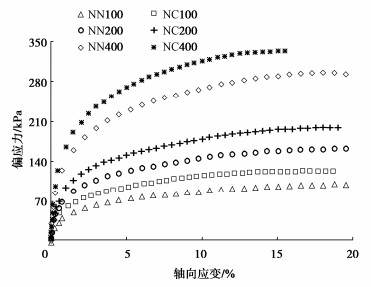
 下载:
下载:
